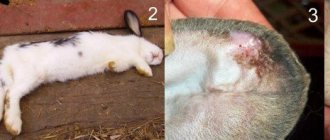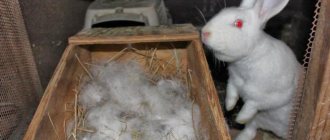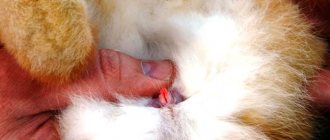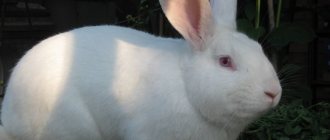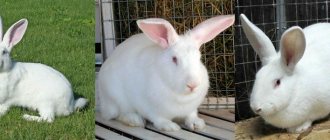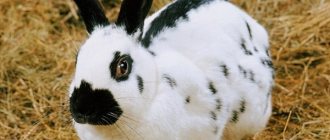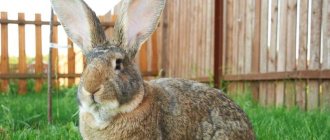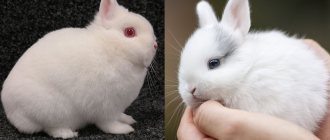Coccidiosis is a common infectious disease among rabbits. When kept in a herd, the disease can cause the death of up to 85% of the total livestock, which causes irreparable damage to the breeder.
It is worth noting that not only rodents are susceptible to coccidiosis, but also poultry and ungulates. But each type of animal is parasitized by different types of pathogens, and transmission, for example, from chickens to rabbits is impossible.
What is coccidiosis in rabbits?
Coccidiosis in rabbits is caused by protozoa - coccidia - single-celled parasites that can only be detected under a microscope. There are many varieties. In rabbits alone, coccidiosis can be caused by up to 10 subspecies, and this does not count the species that parasitize other animals.
Parasites adapt well to environmental conditions, so fighting them is not easy. Only fire or boiling water can destroy the pathogen. At the same time, coccidia persist in manure for 3 months, and in pasture for up to 1 year. Rabbits are parasitized by eimeria, a specific variety of exclusively “rabbit” coccidia, which is why the disease is also called eimeriosis.
Sources and factors of infection
Sources of infection can be food, water, milk, manure, which contain coccidia.
The main route of infection is oral (through the mouth). Eimeria eggs (oocysts) can be released in the feces of previously ill rabbits. Little rabbits are susceptible to infection from the first days of life if they are fed milk by a sick female.
Coccidia can also be transferred from a sick animal that entered the herd and did not undergo quarantine. Don't forget about flies, rodents, dirty cleaning equipment or unwashed hands of service personnel. All this could be one of the ways to transmit protozoa to rabbits.
Outbreaks of the disease are recorded throughout the year, but most often in autumn and spring. Young eared animals up to 3-4 months of age are considered the most susceptible to infection. Adult rabbits are only carriers of the pathogen, and exacerbation of the disease in them is extremely rare.
A number of factors can contribute to the rapid proliferation of parasites:
- Unsanitary conditions in the area where households are raised.
- Cool, wet weather.
- Contact of healthy rabbits with their relatives who have previously suffered from coccidiosis.
- Ingress of coccidia oocysts into the water and food of rabbits through contaminated and insufficiently disinfected equipment.
- Helminthic lesions and bacterial infections of eared animals, which reduce the protective functions of the gastric and intestinal mucosa, as well as general resistance.
Reasons for development
Coccidiosis occurs when the conditions of keeping eared animals are violated.
Main causes:
- Overcrowding of animals.
- Keeping adults and young animals together.
- Lack of proper cleaning in rabbit farms.
- Changes in temperature and humidity in places of detention, drafts.
- Eating disorder, unbalanced diet.
- Feeding with poor quality food.
- Feeding with milk and high-protein products (an ideal environment for the development of eimeria).
Diagnostics
Before starting treatment for coccidiosis, an accurate diagnosis should be made.
In this case, it is worth taking into account the symptoms, origin of the animal, farming conditions, and laboratory test results. Pathology is also performed. You should take the diagnosis seriously and not confuse it with listeriosis, pseudotuberculosis and cysticircosis.
Symptoms of coccidiosis in a rabbit
After infection, rabbits may not show any obvious symptoms of the disease for quite a long time. Only after rapid insemination and the spread of parasites throughout the body of the eared parasite do the first signs of the disease appear.
The severity of the disease is proportional to the number of coccidia - the more there are in the rabbit’s body, the brighter the picture of the disease becomes. Symptoms depend on the form of the lesion - intestinal, hepatic, mixed.
It is worth remembering about latent carriage, when a rabbit is a carrier of the pathogen, but at the same time does not have any symptoms. In this case, oocysts (eggs) will constantly enter the external environment, which will cause infection of a healthy tribe. To avoid possible carriage, it is recommended to keep rabbits in comfortable conditions and carry out timely prevention of infections.
Symptoms of the intestinal form
Intestinal coccidiosis is the most dangerous type of disease with a rather rapid course and pronounced symptoms:
- The appearance of diarrhea, which alternates with constipation.
- A lot of mucus with blood is visually detected in the stool.
- The animal's body temperature is very high.
- There is noticeable swelling of the abdominal cavity, but the stomach sags.
- The appetite decreases or the animal completely refuses to eat.
- The growth of the body stops.
- Mucus and pus may be discharged from the nose and eyes.
- The coat becomes faded.
- Convulsions are observed before the death of the rabbit.
If left untreated, the rabbit dies within 10-14 days.
Symptoms of the liver form
Hepatic coccidiosis has a latent course (symptoms increase up to 2 months). The symptoms are the same as for the intestinal form. But at the same time, the sclera of the animals’ eyes turn yellow. This form of the disease is treatable and has a favorable outcome.
However, this form of the disease easily becomes chronic, and the animal becomes dangerous to others. To prevent the spread of infection, the infected animal is housed separately until complete recovery or death (in the event of a repeated exacerbation of the disease, death is inevitable).
The occurrence of mixed liver and intestinal symptoms in one rabbit clearly leads to death. But at the same time, the animal becomes exhausted very quickly. Single convulsions of the back, paws, and neck are noticeable, which signal impending death. The duration of coccidiosis with a mixed course is up to 3.5 months.
The final diagnosis is made after an autopsy, microscopy of stool and based on symptoms. Under a microscope, coccidia eggs are found in the stool.
Signs in pathological anatomy
The diagnosis of coccidiosis can be fully confirmed after the death of the rabbit.
At the autopsy it is noted:
- The intestinal mucosa is swollen, red, with a white coating.
- White nodules with a cheesy content on the mucous membranes and liver are visually detected.
- The bile ducts are greatly dilated.
Signs in pathological anatomy
The disease can be diagnosed without difficulty at autopsy.
In the case of intestinal eimeriosis, redness of the mucous membranes of the intestine, layers, the structure of which resembles cottage cheese flakes, are noted; dirty white or grayish spots and constrictions, similar in size to poppy or pea grains, are found in the small intestine. Purulent and necrotic lesions are also detected.
In the situation of hepatic coccidiosis, upon autopsy, flat white spots are found in the liver tissue, uneven surfaces of the bile ducts are found due to the presence of cavities, and microorganisms E.stidae are detected under a microscope.
How to treat coccidiosis in rabbits
With coccidiosis, as with any other disease in rabbits, you should not self-medicate. To make a diagnosis and prescribe a treatment regimen, you should immediately contact a veterinarian!
Before the veterinarian arrives, you must:
- Place the sick rabbit in a separate cage in a dry, well-lit, well-ventilated room.
- Isolate the eared animal from contact with feces as much as possible.
- Offer the animal high-quality, high-calorie food.
How to give medications
All information presented below about the treatment of animals is provided for informational purposes. Only a doctor can choose rational treatment in practice in each specific case!
Rabbit coccidiosis is treated comprehensively: with the help of coccidiostats, which destroy the causative agents of the disease, antibiotics and probiotics to restore healthy microflora.
Coccidiostatitis _
| Drug name | Treatment | Notes |
| Baycox | A one-time intramuscular injection of 2 ml of the drug is administered to an infected rabbit, then drink it - 0.2 ml per 1 kg of body weight. The instructions say that the sick animal should be given 10 ml of water per day for 3 days. | Baycox is considered the best in treatment. For prevention, give before vaccination, and then 2 times a year (give 1 ml of the product per 1 liter of water for two days). Not approved for use in pregnancy and small rabbits. Exceeding the dosage may cause anorexia. Nowadays, an analogue of Baycox, coccytox, is also popular among rabbit breeders. |
| Solikoks | Drink 0.4 ml per 1 kg of live weight for 2 days. | As a prophylactic measure, Solicox is given to one-month-old eared cats before vaccination against myxomatosis - the same dose as for treatment. |
| Amprolium | Add 1 g of the drug to 1 liter of water or feed and give it for three weeks. | Can be used for prevention. Due to its very low toxicity, it is allowed to be given to rabbits from 2 weeks of age. |
| Brovitacoccid | 2.5 g of the drug is added to 1 liter of water and drunk for 5 days. | For the purpose of prevention, give 21 days (1 g of the drug per 1 liter of water). |
| Stop coccid | Can be administered intravenously or administered at the rate of 0.14 mg per 1 kg of weight. | Can be used prophylactically. Contraindicated in pregnant females and when breastfeeding. |
| Eimetherm | Give orally to rabbits from one month of age: 0.14 ml per kg of weight just once. | In case of severe infection, the course is repeated after 5 days. |
| Diclacox | Breastfeed with food or drink with drinking water: 0.4 ml of substance per kg of body weight per day – 2 days. | Do not give to lactating or pregnant females. |
| Unicoccide | Water for 2 days - 0.4 ml per 1 kg of weight. | |
| Chemical coccide | Calculated - 30 mg/kg body weight twice for 5 days for 5 days with a break of 3 days. |
Antibiotics
| Drug name | Treatment | Notes |
| Phthalazole | 0.1 g/kg - added to drink - 5 days. | Fthalazole can be combined with Norsulfazole: 0.3 g of Norsulfazole and 0.1 g of Fthalazole per 1/kg of weight - 5 days. After a 5-day break, the treatment is repeated. |
| Norsulfazole 0.5% | 0.4 g/kg – fed – 5 days. | |
| Sulfapyridazine 100 mg | Add to drink. | |
| Sulfadimethoxine | The medicine is given on day 1 - 0.2 g/kg, days 2-5 -0.1 g/kg. After a 5-day break, the course is repeated. | Not used for hepatic coccidiosis. |
| Nomitsin | Administer intramuscularly at 25,000 units/kg. | |
| Salinomycin | 3-4 mg/kg. | |
| Vetrokoks (Ditrim) | Give at a rate of 1 ml/l of water for 5 days. | |
| Biofuzol (Nifulin) | Add -5 g/kg of feed to food for 7 days. | |
| Furazolidone | For 10 days, twice a day, the rabbit is given the drug at the rate of 30 mg / kg kilogram of weight with food. | Not possible during pregnancy. |
| Enrofloxacin (Baytril) | The 2.5% drug is used at 0.1 ml/kg body weight 2 times a day for 7 days intramuscularly (5% solution is administered once a day). | Do not use during pregnancy and lactation, for liver and kidney diseases. |
| Levomycetin | Drink with water to which the substance is added at 40 mg/kg body weight. | Rarely used. The effectiveness of the treatment has not been proven. |
| Sulfadimezin | A solution containing the drug 150 mg/kg. |
Probiotics
| Drug name | Treatment | Notes |
| Olin | After taking antibiotics, use a double dose of powder - 0.6 g / kg of eared body weight. By adding powder to food for 2 weeks. | For prevention, give 0.3 g/kg body weight in a weekly course, repeated several times a year. |
| Zoonorm | Add 5-10 doses per day to your diet for a whole week. If necessary, the dosage is increased three times. | Can be used for prevention purposes. |
Treatment with folk remedies
Despite the fact that modern veterinary medicine boasts a huge list of drugs, many rabbit breeders refuse to use them and fight with the help of proven folk remedies. Such substances are non-toxic, safe and at the same time quite effective. Traditional methods include the use of iodine solutions, lactic acid, and apple cider vinegar.
Video COCCIDIOSIS IN CHILDREN RABBIT? THE VERY FIRST STAGE OF THE FIGHT AGAINST THIS INFECTION
Iodine mixtures.
Iodine stops the proliferation of coccidia and promotes oxidation in the stomach.
Iodine treatment regimen for rabbits:
| 25th day of pregnancy | The rabbit is given 100 ml of 0.01% iodine solution daily. | With this use, rabbits who receive iodine compounds in their milk also receive protection. |
| 5 days after birth | Iodine is removed from the female's diet. | |
| 15 days after lambing | They start giving iodine again, but this time in 200 ml of a 0.02% solution. | |
| Young animals after weaning from a female rabbit | The rabbits are given 50 ml of 0.01% iodine solution for 10 days, then a break of 5 days and a 2-week repeat of the course - 100 ml of 0.02% iodine solution. |
Lactic acid for rabbit coccidiosis
Lactic acid has a wide range of uses:
- as a food additive, it improves the metabolism of eared animals and stops fermentation in the intestines of animals;
- acts as a preservative for feed;
- helps fight different types of bacteria in the form of a disinfectant;
- promotes recovery from enteritis, gastritis, trichomoniasis, tympany, flatulence, coccidiosis;
- is a good prevention of coccidia infection after the young are separated from the female.
But despite all the positive aspects, lactic acid, unfortunately, does not destroy coccidia. Therefore, it can only be used as an adjuvant in the treatment of coccidiosis.
Lactic acid treatment regimen: for treatment, 4-6 ml of a 2% or 3% lactic acid solution is poured into drinking bowls until complete recovery. During an exacerbation, the dose can be increased to 8 ml per day for one animal. The drug is given prophylactically for 3-4 days in the same volume as during treatment.
Apple cider vinegar for rabbits against coccidiosis
An alternative to traditional chemotherapy treatment may be the use of apple cider vinegar. Experienced breeders claim that apple cider vinegar destroys coccidia. First 2 tbsp. spoons of 5% vinegar are diluted in 5 liters of water. Rabbits from 3 weeks to 4 months of age are fed a diluted solution every day.
It is worth remembering that the first signs of coccidiosis appear only 3-4 days after infection.
Therefore, the entire rabbit population must be cured: even if there are no visible signs of the disease, there is no guarantee that the animals have not become infected. It is important to carry out timely therapy and provide even healthy animals with appropriate means for prevention in a timely manner. Before feeding, rabbits are provided with comfortable living conditions.
The hepatic form of coccidiosis is sensitive to therapy only at the onset of the disease. If you miss the beginning, the death of rabbits cannot be avoided. But even with successful therapy, a relapse of the disease can occur with a fatal outcome after 1-2 weeks. To prevent the return of coccidia, the dosage of medications for drinking is increased in case of hepatic coccidiosis.
About the disease and pathogen
Coccidiosis is caused by protozoan endoparasites (coccidia) belonging to the class Sporozoans and the genus Eimeria, which is why the pathology is also called eimeriosis. They parasitize animals of all species, as well as humans, and have sexual and asexual development cycles. When parasitizing mammals, both of these cycles are carried out in the body of one host; intracellular parasites affect blood cells, liver parenchyma and bile ducts, as well as the epithelium of the small intestine.
In livestock production, coccidiosis is most common in rabbits, pigs and birds. Its wide distribution, despite the modern development of veterinary medicine, is due to many factors, including the adaptation of the pathogen to the chemotherapeutic drugs used for treatment and prevention.
Factors contributing to the spread:
- Intracellular method of parasitism in the host body.
- Excessively active reproduction (in the host’s body, one oocyst can, depending on the species, reproduce from 100 thousand to 2 million individuals).
- Coccidia spores - oocysts consist of a double-circuit shell, which is resistant to most agents used for disinfection.
- The combination of two methods of reproduction (asexual and sexual) makes it possible to develop immunity to the effects of drugs (thanks to genetic exchange).
Eimeriosis of rabbits was first discovered by Leeuwenhoek back in the 17th century, but a detailed description appeared only in the late thirties of the 19th century (Geik). There are about 10 varieties of coccidia that parasitize rabbits (according to foreign authors - up to 25 species, this is due to the fact that some species have several names). Most varieties of the pathogen parasitize in the cells of the intestinal epithelium (cause the intestinal form of the disease), and some in the liver (hepatic form); most often, several species parasitize at the same time.
The disease can often be complicated by a secondary bacterial infection (in particular, E. coli), which is caused by decreased immunity and the development of inflammatory processes in the intestines and liver. The death of animals occurs as a result of poisoning by toxins produced during the life of the pathogen and during rotting of the intestinal contents, resulting from inflammation or from developing secondary infections. Considering the diseases of rabbits, coccidiosis, due to its high mortality (especially in young animals) and mass distribution, can confidently be classified as the most dangerous, along with such viral diseases as hemorrhagic disease and myxomatosis.
Prevention of coccidiosis in rabbits
Due to the lack of vaccination against coccidiosis, disease prevention is very important - a series of measures to suppress parasite infection.
The main preventive measures include:
- regular cleaning of rabbit hutches, ventilation (the cages must be spacious, clean, disinfected - once every 7 days they are watered with boiling water or treated with ultraviolet light, and also sprayed with an ammonia solution or other disinfectant that acts on coccidia);
- daily washing of feeders and drinkers;
- restricting access to the ears of strangers and other animals;
- separate keeping of young and adult rabbits;
- treatment of nipples in lactating rabbits;
- control of the diet (it is undesirable to allow an excess of foods high in protein, as well as low-quality, spoiled food; the animals are given a lot of drink; foliage rich in tannins (from fruit trees, pines, ash, oaks), vitamins A and B are added to the food );
- organization of proper feeding (prevent feces from getting into the feeders and drinking bowls);
- isolation of acquired individuals (quarantine for 1 month);
- soldering eared animals with prophylactic agents: Zoalen (given at the rate of 250 mg of the drug per 1 kg of feed daily for 10 days); Robencox; Unicoccide. Prevention medications are given every month throughout the year.
For preventive purposes, rabbits are fed special feeds and nutritional supplements that contain drugs against eimeriosis. But they are used with caution (especially for decorative breeds), because coccidiotoxic agents tend to accumulate in tissues and poison the animals’ bodies when they become oversaturated.
In the event of an outbreak of coccidiosis, all premises, rabbit hutches, and equipment are disinfected. The cells are scorched with a blowtorch, and everything that goes to waste is burned.
History of the study
For the first time, parasitic organisms were found by the Dutch naturalist Antonie van Leeuwenhoek, but this event went unnoticed by the scientific world. Only more than a century and a half later, active study of coccidia began, which subsequently allowed scientists to prove that it is these single-celled round-shaped microorganisms that cause eimeriosis in representatives of the Zaitsev family.
Spread and infection
The most favorable conditions for the development of the disease are the warm season, namely with high humidity and temperatures from 20 to 30 degrees, the sporogony stage (development of the parasite outside the host body) occurs the fastest (1-3 days), under other conditions from 4 to 6 days . Therefore, the peak incidence occurs in the summer months, although animals can get sick at any time of the year.
The spores are little susceptible to external influences and can persist in the external environment for a long time (up to a year). Only very high (from 80 to 100 degrees) temperature has the most detrimental effect on them - death within a few seconds. At a temperature of 55 degrees, this already takes a quarter of an hour. Also, partial death of oocysts occurs at low temperatures (below 15 degrees). The effective action of chemicals used for disinfection requires a large amount of time, which presents certain difficulties in their use.
Eimeria (coccidia) are isolated from the body of a sick rabbit along with feces. Animals become infected through nutrition (through the mouth), the sources of infection are contaminated:
- Food and water.
- Mother's nipples (rabbits can become infected from the very first days of life).
- Feces of sick rabbits.
- When eating one's own feces (coprophagia), re-infection occurs.
A necessary condition for spread is the presence of contaminated sources of infection in the rabbitry for more than a day (the minimum time required for completion of sporogony), which must be taken into account during prevention.
How does the infection progress?
The infection is transmitted from an infected rabbit to a healthy one. Feces excreted by sick animals contain coccidia cysts. The infection spreads through feces onto food and drinking water. A few days are enough for all animals living in one cage to become infected.
Infection with coccidiosis is inevitable if a sick mother rabbit feeds her babies milk with parasites.
Most often, coccidiosis is detected in young animals. The reason is that by 4 months of age, rabbits have transitioned from their mother's milk to adult food, and their immune system is still weak.
A healthy mother rabbit means healthy rabbits.
There is a risk of infection in rabbits if meadow grass is used as feed. It may contain traces of wild mouse droppings containing coccidia cysts.
Types of diseases
Depending on the area of distribution of infectious agents, the disease can be of the following types:
- Intestinal coccidiosis;
- Coccidiosis of the liver.
The symptoms of these types of infection occur differently. To prescribe the correct treatment, it is necessary to know the symptoms of the two types of coccidiosis in order to recognize it in time and begin treatment immediately.
Preventive actions
To prevent infection of healthy individuals at risk, the following recommendations must be followed:
- observe sanitary rules in the rabbits’ habitat - regularly clean and disinfect cages;
- do not create cramped conditions when placing animals, especially those of different ages;
- use high-quality, well-balanced feed;
- If necessary, change feed gradually;
- exclude high humidity, drafts, sudden temperature changes;
- keep newly arrived animals in quarantine for 30 days.
A specialist’s opinion about the characteristics of coccidiosis and effective preventive methods can be found in the video below:
In a comprehensive fight against the disease, it is necessary to thoroughly disinfect the premises where animals are kept, as well as all available equipment. It should be remembered that coccidia in the form of oocysts is extremely stable, so the most effective way to disinfect cells is to treat them with fire using a blowtorch. You can also use special disinfectants, for example “Brovadez plus” (2% solution). Such drugs are especially relevant in the fight against coccidiosis in rabbits kept as pets.
Development of the disease
With a small degree of infection (up to 100 thousand oocysts) and the rabbit’s body is in good condition, the disease may not manifest itself. The following conditions contribute to the development of the disease:
- Unbalanced diet (vitamin and mineral composition).
- Feeding young animals with coccidiobioses (products that promote the development of coccidia - fat and dry milk, alfalfa and wheat bran, vitamin B6).
- High protein feeding (over 10%).
- Low quality feed.
- Abrupt transfer of animals from one food to another.
- With poor feeding and a lack of milk in nursing rabbits, baby rabbits can begin to eat roughage early, which injures their intestines, which are not yet ready for this, causing the development of inflammation. Which, in turn, will cause the development of coccidiosis.
- Anything that can negatively affect the physiological state (stress, hypothermia, draft, infectious diseases, etc.).
- Poor living conditions (overcrowding, placement of young animals together with adults, unsanitary conditions).
